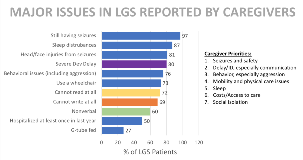Lennox-Gastaut Syndrome: Characteristics and Major Caregiver Concerns (LGS)
Abstract number :
3.180
Submission category :
4. Clinical Epilepsy / 4A. Classification and Syndromes
Year :
2018
Submission ID :
505701
Source :
www.aesnet.org
Presentation date :
12/3/2018 1:55:12 PM
Published date :
Nov 5, 2018, 18:00 PM
Authors :
Tracy Dixon-Salazar, LGS (Lennox-Gastaut Syndrome) Foundation; Melanie Huntley, LGS (Lennox-Gastaut Syndrome) Foundation; and Christina SanInocencio, LGS (Lennox-Gastaut Syndrome) Foundation
Rationale: Lennox-Gastaut Syndrome (LGS) is a severe epileptic encephalopathy syndrome characterized by multiple seizure types, specific EEG features, and cognitive impairment. The onset of seizures is usually between 1-8 years of age and LGS can arise secondary to a number of underlying etiologies, including early life brain injuries, congenital brain malformations, infection, genetic defects, and metabolic disorders. There are an estimated 40,000-60,000 LGS patients living in the U.S. and 80% continue to have seizures throughout their lifetime. There is an increased risk for mortality in LGS, but many patients live well into their 40’s and 50’s and most are severely disabled. To understand the characteristics and caregiver concerns associated with LGS, the LGS Foundation conducted a survey of its membership. Methods: The LGS Foundation distributed an online survey in January 2018 to LGS caregivers. The survey was designed using results from previous published, caregiver-reported surveys and heavily vetted with caregivers, clinicians, and researchers before release. The survey link was posted on the LGS Foundation’s private online support group page (Facebook), consisting of 4500 members, and distributed via email to the foundation’s membership. Participation was voluntary, data were collected anonymously, and permission to use de-identified data was obtained at the beginning of the survey. Data were collected on demographics, LGS characteristics, possible comorbidities, medications and efficacy, and caregiver concerns. Results: Four-hundred and sixteen primary caregivers responded to the survey (94% parents), from 17 counties (89% from the US). Patients’ age ranged from 7 months to 60 years, with nearly 50% over the age of 16 years. Previous Infantile Spasms was reported in 45% and time to diagnosis of LGS was 3 years or more in 55%. Underlying etiology of LGS is reportedly known in approximately 90% of cases, but only 33% of caregivers reported knowing the cause. 75% of patients were on 3 or more therapies for their LGS, and 97% were regularly having seizures. The most common seizure types were Generalized Tonic Clonic (GTC), Atypical Absence/Absence, Tonic, Myoclonic, and Atonic. The most problematic seizure type reported was GTCs. In addition to seizures, caregivers also reported sleep disturbances in their loved one (87%), severe developmental delay (80%), behavioral issues (76%), wheelchair use (73%), nonverbal (60%), and tube feeding (27%). When asked to list the top three issues their loved one was currently facing, caregivers overwhelming responded with seizures and safety as a major issue. Next came developmental delay (especially communication), behavioral issues (especially aggression), mobility and physical care issues, sleep issues, cost and access to care, and social isolation. Conclusions: LGS represents a lifelong disability for most patients and caring for these patients exerts substantial stress on caregivers. These findings highlight an unmet need for better treatments for LGS, offer insight into caregiver priorities on the backdrop of multiple chronic conditions in LGS, and identify potential areas where supportive services would be meaningful in reducing the overall impact on caregivers. Funding: This work was performed and funded by the LGS Foundation.

.tmb-.png?Culture=en&sfvrsn=983bccda_0)